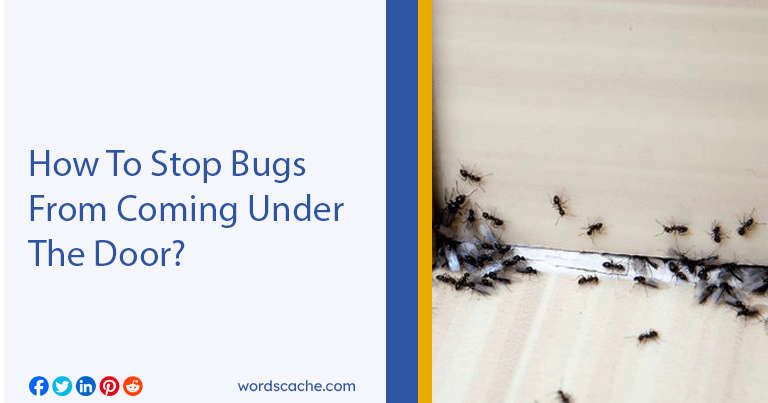How To Stop Bugs From Coming Under The Door? Ultimate Guide
Dealing with bugs in your home can be really annoying, and sometimes they can even make us sick. Bugs like flies, mosquitoes, and cockroaches find small ways to get into our homes, like under doors. To keep your home bug-free, it’s important to block these tiny entrances.
Bugs come inside for food, water, and a cozy place to stay. If we cut off their food and hiding spots, it’s less likely they’ll hang out in our homes. But the best thing to do is stop them from getting in at all. This means checking your doors and windows for small gaps they can crawl through.
In this guide, we’ll focus on how to keep bugs from coming under your door. It’s easier than you think! We’ll talk about simple fixes like using door sweeps and sealing gaps to keep your home safe and comfortable. Let’s learn how to make your home a no-bug zone!
Install the Necessary Features of Bug Proof Doors
Firstly, let’s talk about reinforcing your doors against bugs. There are three key features to consider: a steel or aluminum threshold, a door sweep, and weatherstripping.
- Steel or Aluminum Threshold: This is a barrier at the bottom of your door. It bridges the gap between the door and the floor, making it harder for bugs to crawl in. Steel and aluminum are great materials because they’re durable and long-lasting.
- Door Sweep: This is a strip attached to the bottom of your door. It sweeps over the floor when you open and close the door, blocking the gap that bugs can use to enter. It’s an easy and effective solution.
- Weatherstripping Around the Door: This involves sealing the gaps around the entire door frame. Weatherstripping can be made of foam, rubber, or other materials. It’s an inexpensive way to make sure there are no tiny openings for bugs to slip through.
5 Ways to stop the bugs under the door

1 – Maintain Your Yard to Prevent Bug Infestation
Believe it or not, the state of your yard plays a crucial role in whether or not bugs decide to make your home theirs. When you leave your yard unkempt, with overgrown grass and piles of debris, you’re essentially rolling out the welcome mat for pests. Overgrown grass provides the perfect hiding and breeding ground for many insects. It’s like a miniature jungle where they can thrive undisturbed. To counter this, it’s essential to keep your lawn well-trimmed. Regular mowing doesn’t just improve the look of your yard; it also disrupts the habitat bugs love, making your yard less appealing to them.
Another critical factor to consider is stagnant water. This can accumulate in places like old tires, empty planters, and even small dips in your yard where rainwater collects. Stagnant water is a breeding paradise for mosquitoes and other water-loving pests. By ensuring that your yard is free from standing water, you significantly reduce the risk of a bug infestation. This might involve emptying containers after rainfall, fixing areas where water pools, or even installing better drainage solutions.
Debris, such as fallen leaves, twigs, and random yard waste, can also attract bugs. These materials provide shelter and food for a variety of insects. Regularly clearing away yard waste and keeping your outdoor space tidy can greatly deter bugs from taking up residence. By maintaining a clean and well-groomed yard, you’re essentially cutting off the resources bugs need to survive, making your home much less attractive to them. So, remember, a little yard maintenance can go a long way in keeping your home bug-free.
2. Seal Any Breaches in Your Home’s Perimeter
Sealing any breaches in your home’s perimeter is essential in the fight against bugs. It’s surprising how often small cracks and gaps are overlooked, but for bugs, these are prime entry points. Start by thoroughly inspecting your home’s exterior. This means carefully examining the entire structure, paying special attention to areas that are more prone to gaps, such as where utility pipes and wires enter the house. These spots often have small openings that are perfect for pests to slip through.
Next, consider the materials you’ll need for sealing these breaches. Caulk is excellent for sealing smaller cracks, especially around window frames and door edges. For larger gaps, especially in areas like the foundation, you might need something more substantial, such as cement or a specialized sealant. Remember, the goal is to leave no space unsealed, no matter how small it may seem.
Regular maintenance is also key. Over time, your home settles, and new cracks can appear. Making a habit of inspecting and sealing your home at least once a year can greatly reduce the likelihood of bugs finding their way in. By taking these proactive steps, you’re not just fixing current problems, but also preventing future infestations.
So, grab that caulk gun and start sealing – your bug-free home will thank you for it!
3 – Keep Your Home Clean and Clutter-Free
To keep bugs away, a clean and tidy home is key. Bugs are attracted to places where they can find food and hide, so if your house is messy, it’s inviting for them.
Regularly vacuuming your floors and wiping down counters is important because it gets rid of crumbs and spills that attract bugs. Remember to clean under appliances and furniture too, as food particles often hide there.
Storing food in airtight containers is also crucial; it keeps bugs from getting to your food. This includes pet food – if it’s left out, it can draw bugs.
A simple routine of cleanliness and order not only makes your home look better, but it also makes it less welcoming to pests.
4 – Ensure Doors and Windows Close Properly
Ensuring that your doors and windows close properly is vital in keeping bugs out of your home. When these entry points don’t shut completely, they can easily become gateways for pests to enter.
Start by checking all your doors and windows to make sure they close tightly. Sometimes, issues can be as simple as a hinge needing adjustment. Other times, you might find damaged parts that need replacing.
In certain situations, the best solution for a bug-free home might be to install new doors or windows. This ensures a secure and tight fit, leaving no space for bugs to sneak in. Regular checks and maintenance of doors and windows are key steps in pest-proofing your home.
5 – Repair Cracks
Repairing cracks in and around your home is a crucial step in preventing bugs from entering. Cracks in walls, floors, and foundations can easily become entry points for pests. Even small cracks that might seem insignificant can be big enough for bugs to get through.
Start by inspecting your home for any visible cracks. Pay special attention to areas where walls meet the floor, window frames, and door frames, as these are common places for cracks to develop. Once you identify them, use an appropriate filler or sealant to close these gaps.
For larger cracks, especially in the foundation or exterior walls, you might need a more robust solution like cement or a specialized sealing compound. Regularly checking for and repairing cracks not only helps in keeping bugs out but also maintains the structural integrity of your home. Remember, prevention is key, and taking care of these small repairs can save you from bigger pest problems in the future.
Conclusion
In conclusion, keeping your home free from bugs involves a combination of proactive measures and regular maintenance. From sealing cracks and ensuring that doors and windows close properly, to maintaining cleanliness and order inside your home, each step plays a crucial role in creating a bug-resistant environment.
Remember, the key to effective pest control is not just in reacting to an infestation, but in preventing one from happening in the first place. Regular checks and upkeep can seem like a chore, but they are essential in safeguarding your home against unwanted guests. By following these simple yet effective strategies, you can enjoy a comfortable, healthy, and bug-free living space. Keep in mind that consistency is vital; a little effort goes a long way in keeping your home a no-bug zone.
Related Articles:

